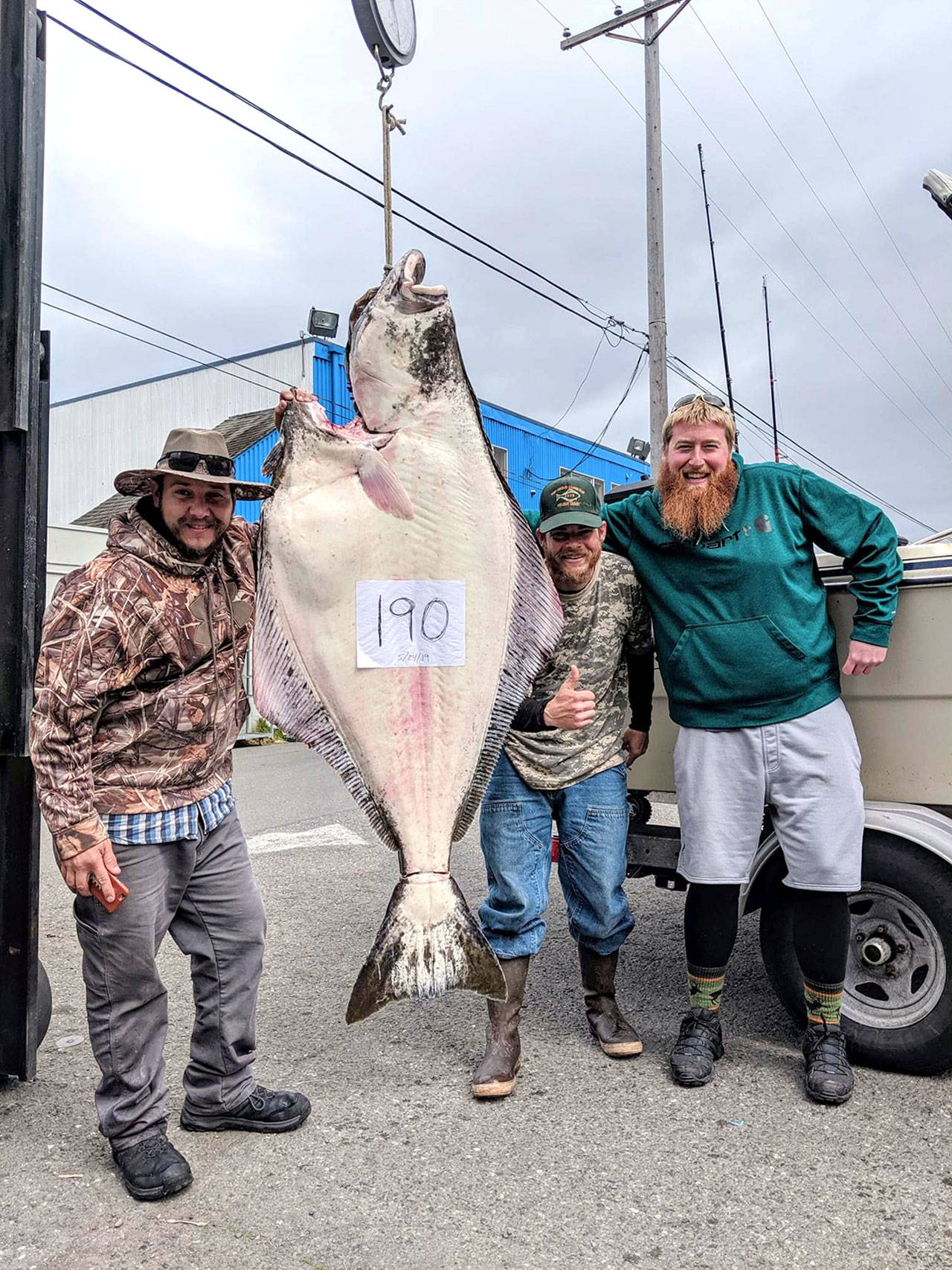By Michael Carman
Peninsula Daily News
PORT ANGELES — A trio of Port Angeles anglers landed the biggest halibut of the season — 190 pounds — while fishing in 100 feet of water in the Strait of Juan de Fuca on Friday morning.
Nick Roberts, Craig Rice and Bob Harrison teamed to bring aboard the monster flatfish.
“Nick Roberts, he was the one who reeled it in,” Harrison said.
“Craig and I had been fishing all season on his dad’s [Dave Rice’s] boat [At Ease]. He and his dad had fished halibut without much success for four years and were just about ready to give it up when I started to show him some spots and how I setup this season,” Harrison said.
“Craig and Nick both work at Swain’s and Nick took a day off for his birthday earlier in the season and didn’t get anything. Nick took Friday off as well, so Craig and I made the pact that first bite goes to Nick.”
It’s the second time Harrison has been on a boat that caught a halibut in excess of 150 pounds — he and Leanne Price brought in a 155-pounder in 2017.
Harrison said they were fishing off Port Angeles, anchored in 100 feet of water with a spreader bar, a 2-pound weight and full green label herring on a 9/0 hook on the downriggers.
“A lot of guys ask me what color hoochie are you using,” Harrison said.
“To me, it’s pretty simple — whole herring on a spreader bar.”
The fish hit the rod a little before 7 a.m. Friday and Harrison said it peeled off line for about 300 yards.
Roberts began the laborious process of getting the fish close enough to the boat to land a harpoon.
“We got it close to the boat a couple of times, not close enough to harpoon it,” Harrison said. “We were finally able to harpoon it and it turned out we had two fishing lines attached to the harpoon line, so two lines attached to the fish.
When we got it to the boat I put a tail rope on it, and before we even pulled it out of the water I said, ‘Nick, this fish is 200 pounds.’”
“All three of us counted 1-2-3 and lifted it up and on. When we got it aboard, it was like another full-grown man had joined us on the deck.”
Harrison said the fish was in good shape, with just a small patch of worms near its guts.
“I’ve had small 20 pounders that are covered with worms,” Harrison said. “I think it just matters what they are feeding on.”
Since it was the first bite of the day on a day where the weather and winds were cooperating, Harrison said he and Rice did keep fishing for their daily limit of one halibut.
“The forecast called for it picking up a little bit, but it was flat and gorgeous,” Harrison said. “A little overcast, but nice and cool. We were not worried about leaving the fish in the sun. It was meant to be.”
Harrison did say there was conversation about heading in immediately after the big catch.
“We all debated on whether or not we were being greedy,” Harrison said.
“It was such a nice day and we don’t have too many good days like that during halibut season.”
Harrison offered his opinion when asked what he would say to those who criticize keeping such large halibut.
“It’s a legal fish, we are following all the rules,” Harrison said. “Canada has a size restriction (non-retention of halibut more than 133 centimeters or 52 inches in length). “That’s cool and I understand how the big ones do breed, but at a certain point they stop breeding and just eat everything around them. This one had a 3 1/2-foot fish in it’s stomach.”
And Harrison said catch-and-release isn’t always an option when you hook into a halibut.
“That big fish swallowed hooks all the way down to its stomach,” Harrison said. “Even if we hadn’t kept the fish it was going to die pretty quickly.”
And the fish will be put to good use, starting with a fish fry today.
“We aren’t out there trophy hunting,” Harrison said. “We are fishing for halibut to eat.”
He said he had finished off the fillets leftover from the 155-pounder just before the start of the 2019 halibut season.
“It was great [eating],” Harrison said. “A lot of people say its tough, but I think we were eating halibut fillets right up until this season.
“We actually put the fish to good use. We collect the ivory, the ear bones, you can make jewelry out of that. That’s the otolith, what you can use to find out how old it is like counting the rings on a tree.”

